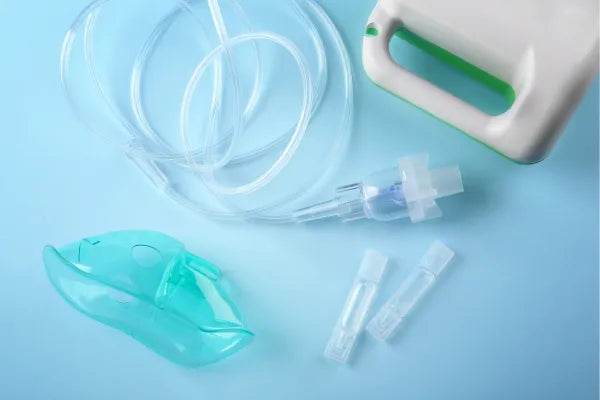
Is PEP and PEEP Same? Which One to Use for COPD?
Share
Is PEP and PEEP Same?
Listen to this Article
Overview
Chronic Obstructive Pulmonary Disease (COPD) is a progressive lung condition that makes breathing difficult, and effective management of COPD is crucial for improving quality of life. Among the various treatments and therapies available, Positive Expiratory Pressure (PEP) and Positive End-Expiratory Pressure (PEEP) are two commonly used methods.
While both PEP and PEEP help improve breathing and reduce symptoms of COPD, they serve different functions. PEP is generally used for airway clearance and reducing air trapping. It is applied by using different devices that you can use by your self or with the help of your medical team. On the other hand, PEEP is mainly applied in clinical settings to keep the lungs expanded and improve oxygenation, particularly during mechanical ventilation (ventilator) or when using CPAP and BiPAP machines. Understanding their differences can help you discuss the appropriate therapy with your healthcare provider based on your COPD condition and needs.
What is PEP?
Positive Expiratory Pressure (PEP) is a type of therapy that involves exhaling against resistance. This method helps keep the airways open, reducing air trapping and improving airflow in the lungs. It is commonly used in managing COPD to alleviate symptoms like breathlessness and improve overall lung function. Some PEP devices also create vibration to help mobilize the mucus in the lungs.
Benefits of PEP
- Helps improve lung function by facilitating mucus clearance.
- Prevents airway collapse and reduces air trapping in the lungs.
- Enhances overall respiratory muscle strength and breathing efficiency.
- Improves oxygen levels.
PEP Use in COPD
PEP is primarily used to help manage chronic symptoms of COPD, especially in patients who experience difficulties with mucus retention and air trapping. It can be used during exercise, as part of pulmonary rehabilitation, or at home as a part of daily care. PEP therapy has been proven to improve symptoms and reduce flare-ups in many COPD patients.
Types of PEP
There are several types of devices used for PEP therapy:
- PEP Mask: A mask that delivers positive pressure to help clear the airways. It needs to be attached to a source of air-pressure.
- PEP Valve: A handheld device that provides resistance during exhalation.
- PEP Devices with Vibration: Specialized devices designed for use in home care or rehabilitation settings to assist with breathing techniques. Some devices also create air vibration to loosen up the mucus in the lungs. Examples of such devices are Aerobika and Accapella.
- PEP Buddy: This is a hands-free portable PEP device that can be used while sitting and during activities. It makes it easy to get breath regulation and PEP whenever needed.

What is PEEP?
Positive End-Expiratory Pressure (PEEP) is the pressure that remains in the lungs at the end of exhalation. It is commonly used in mechanical ventilation to keep the lungs open and improve oxygenation in patients with severe respiratory failure, including those with COPD.
Benefits of PEEP
- Helps maintain the open state of the alveoli (air sacs) in the lungs.
- Prevents the lungs from collapsing and improves gas exchange.
- Reduces the work of breathing and supports ventilation during acute COPD exacerbations.
- Decreases the risk of atelectasis (lung collapse) in patients with COPD.
PEEP Use in COPD
PEEP is typically used in a hospital setting, particularly during mechanical ventilation for COPD patients who are experiencing severe symptoms or respiratory failure. By maintaining positive pressure in the lungs, PEEP supports the patient's ability to breathe, ensuring better oxygenation and reducing the risk of further lung damage.
Types of PEEP
There are two primary types of PEEP commonly used in clinical settings:
- Continuous Positive End-Expiratory Pressure (CPAP): A continuous pressure applied throughout the breathing cycle.
- Bilevel Positive Airway Pressure (BiPAP): A variable pressure therapy that provides different pressures for inhalation and exhalation, used in patients with more severe respiratory distress.

Key Differences Between PEP and PEEP
The key difference between PEP and PEEP lies in their function and application. PEP is typically used to clear the airways and reduce air trapping in patients with COPD. It is often used at home or in rehabilitation settings. PEEP, on the other hand, is a technique used in clinical settings, especially with mechanical ventilation, to prevent lung collapse and improve oxygenation during acute exacerbations of COPD.
Conclusion
Both PEP and PEEP are valuable therapies in the management of COPD. PEP is used primarily for managing symptoms and improving lung function, while PEEP is applied in more critical settings to maintain lung expansion and support breathing. Understanding the differences between these two therapies can help you and your healthcare provider choose the most appropriate treatment plan for managing COPD and improving your quality of life.
Summary Points
- PEP is used to improve lung function and clear airways in COPD patients.
- PEP can be applied by the person themselves using different devices.
- PEEP helps maintain lung expansion and oxygenation in severe COPD cases.
- PEEP is applied on ventilators, CPAP machine and BiPAP machines.
- PEP is typically used in home care, while PEEP is used in hospitals during ventilation.

